Performance of an Adsorptive Heat-Moisture Regenerator Based on Silica Gel–Sodium Sulphate
Abstract
1. Introduction
2. Materials and Methods
2.1. Adsorptive Regenerator
2.2. Adsorptive Regenerator Operation
2.3. Data Processing
3. Results and Discussion
4. Conclusions
Author Contributions
Funding
Conflicts of Interest
Nomenclature
| Symbols and abbreviations | ||
| A | adsorption | (kg/kg) |
| B | empiric factor (Equation (16)) | |
| c | specific heat capacity of air | (kJ/(kg·°C)) |
| C′ | volumetric heat capacity of air | (kJ/(m3·°C)) |
| C | absolute humidity | (kg/m3) |
| d | diameter | (m) |
| H | thickness | (m) |
| ΔH | specific heat of water vapour adsorption | (kJ/kg) |
| Δh | molar heat of water vapour adsorption | (kJ/mole) |
| F | area | (m2) |
| L | air consumption | (m3 per hour) |
| M | mass | (kg) |
| N | fan power input | (W) |
| Q | heat load | (kJ) |
| Δp | pressure difference | (Pa) |
| Rel | Reynolds criterion for flow through adsorbent layer | |
| t | temperature | (°C) |
| V | volume | (m3) |
| v | volumetric flow | m3/s) |
| w | velocity | (m/s) |
| Subscripts | ||
| ads | adsorbent | |
| ads.inf | adsorption inflow | |
| aft.mix. | after mixing | |
| air | air | |
| e.ch | related to channel (in adsorbent layer) | |
| ext | external | |
| fin. | final | |
| H2O | water | |
| hum | moisture | |
| inf | inflow | |
| in | internal | |
| lc | longitudinal cross section | |
| max | maximal | |
| out | outgoing | |
| outf | outflow | |
| p | pores | |
| r | regenerator | |
| 0r | warm end of regenerator | |
| tem | temperature | |
| s | cross section | |
| str | outside | |
| vent | related to fan (fan efficiency) | |
| y | gas phase | |
| Greek symbols | ||
| β | mass transfer coefficient | (s−1) |
| η | efficiency | (-) |
| ε | fractional void volume | |
| ξ | hydrodynamic resistance of adsorbent layer | |
| μ | molar mass | (g/mole) |
| ρ | density | (kg/m3) |
| τ | time | (s) |
References
- Sarbu, I.; Serbachievici, C. A Comprehensive Review of Thermal Energy Storage. Sustainability 2018, 10, 191. [Google Scholar] [CrossRef]
- European Commission. European Commission. European Union Energy in Figures. In Statistical Pocketbook; Publications Office of the EU: Luxembourg, 2016. [Google Scholar]
- Kim, B.-J.; Park, J.; Jeong, J.-W. Indoor Air Quality Enhancement Performance of Liquid Desiccant and Evaporative Cooling-Assisted Air Conditioning Systems. Sustainability 2019, 11, 1036. [Google Scholar] [CrossRef]
- Ligade, J.; Razban, A. Investigation of Energy Efficient Retrofit HVAC Systems for a University: Case Study. Sustainability 2019, 11, 5593. [Google Scholar] [CrossRef]
- Chiang, C.-Y.; Yang, R.; Yang, K.-H.; Lee, S.-K. Performance Analysis of an Integrated Heat Pump with Air-Conditioning System for the Existing Hospital Building Application. Sustainability 2017, 9, 530. [Google Scholar] [CrossRef]
- Elhelw, M. Performance Evaluation for Solar Liquid Desiccant Air Dehumidification System. Alex. Eng. J. 2016, 55, 933–940. [Google Scholar] [CrossRef][Green Version]
- Qin, M.; Hou, P.; Wu, Z.; Wang, J. Precise Humidity Control Materials for Autonomous Regulation of Indoor Moisture. Build. Environ. 2020, 169, 106581. [Google Scholar] [CrossRef]
- Yuan, J.; Emura, K.; Farnham, C. Effects of Recent Climate Change on Hourly Weather Data for HVAC Design: A Case Study of Osaka. Sustainability 2018, 10, 861. [Google Scholar] [CrossRef]
- Corsini, A.; Delibra, G.; Di Meo, G.; Martini, M.; Rispoli, F.; Santoriello, A. A CFD-based Virtual Test-rig for Rotating Heat Exchangers. Energy Procedia 2015, 82, 245–251. [Google Scholar] [CrossRef][Green Version]
- Tyfour, W.R.; Tashtoush, G.; Al-Khayyat, A. Design and Testing of a Ready-to-use Standalone Hot Air Space Heating System. Energy Procedia 2015, 74, 1228–1238. [Google Scholar] [CrossRef][Green Version]
- Aristov, Y.I. Current Progress in Adsorption Technologies for Low-Energy Buildings. Future Cities Environ. 2015, 1. [Google Scholar] [CrossRef]
- Aristov, Y.I. VENTIREG—A New Approach to Regenerating Heat and Moisture in Dwellings in Cold Countries. In Desiccant Heating, Ventilating, and Air-Conditioning Systems; Enteria, N., Awbi, H., Yoshino, H., Eds.; Springer: Singapore, 2018; pp. 87–107. [Google Scholar]
- Bareschino, P.; Pepe, F.; Roselli, C.; Sasso, M.; Tariello, F. Desiccant-Based Air Handling Unit Alternatively Equipped with Three Hygroscopic Materials and Driven by Solar Energy. Energies 2019, 12, 1543. [Google Scholar] [CrossRef]
- Rogala, Z.; Kolasiński, P. Exergy Analysis of Fluidized Desiccant Cooling System. Entropy 2019, 21, 757. [Google Scholar] [CrossRef]
- Yang, K.-S.; Wang, J.-S.; Wu, S.-K.; Tseng, C.-Y.; Shyu, J.-C. Performance Evaluation of a Desiccant Dehumidifier with a Heat Recovery Unit. Energies 2017, 10, 2006. [Google Scholar] [CrossRef]
- Ge, T.S.; Qi, D.; Dai, Y.J.; Wang, R.Z. Experimental Testing on Contaminant and Moisture Removal Performance of Silica Gel Desiccant Wheel. Energy Build. 2018, 176, 71–77. [Google Scholar] [CrossRef]
- Aristov, Y.I. New Family of Solid Sorbents for Adsorptive Cooling: Material Scientist Approach. J. Eng. Thermophys. 2007, 16, 63–72. [Google Scholar] [CrossRef]
- Belyanovskaya, E.A.; Pustovoy, G.N.; Sukhyy, K.M.; Sergiyenko, Y.O.; Yeromin, O.O.; Prokopenko, E.M.; Gubinskyi, M.V.; Kizek, J.; Lukáč, L. Adsorptive Solar Refrigerators Based on Composite Adsorbents ‘Silica Gel—Sodium Sulphate’. Civ. Environ. Eng. Rep. 2019, 29, 200–208. [Google Scholar] [CrossRef]
- Belyanovskaya, E.; Lytovchenko, R.; Sukhyyy, K.; Yeremin, O.; Sukha, I.; Prokopenko, E. Operating Regime of Adsorptive Heat-Moisture Regenerators Based on Composites «Silica Gel—Sodium Sulphate» and «Silica Gel—Sodium Acetate». J. Chem. Technol. 2019, 27, 158–168. [Google Scholar] [CrossRef]
- Sangerlaub, S.; Kucukpinar, E.; Muller, K. Desiccant Films Made of Low-Density Polyethylene with Dispersed Silica Gel-Water Vapor Absorption, Permeability (H2O, N2, O2, CO2), and Mechanical Properties. Materials (Basel) 2019, 12, 2304. [Google Scholar] [CrossRef]
- Luo, Y.; Tan, B.; Liang, X.; Wang, S.; Gao, X.; Zhang, Z.; Fang, Y. Dry Gel Conversion Synthesis and Performance of Glass-Fiber MIL-100(Fe) Composite Desiccant Material for Dehumidification. Microporous Mesoporous Mater. 2020, 297, 110034. [Google Scholar] [CrossRef]
- Wu, X.N.; Ge, T.S.; Dai, Y.J.; Wang, R.Z. Investigation on Novel Desiccant Wheel Using Wood Pulp Fiber Paper with High Coating Ratio as Matrix. Energy 2019, 176, 493–504. [Google Scholar] [CrossRef]
- Chua, K.J.; Chou, S.K.; Islam, M.R. Integrating Composite Desiccant and Membrane Dehumidifier to Enhance Building Energy Efficiency. Energy Procedia 2017, 143, 186–191. [Google Scholar] [CrossRef]
- Kumar, A.; Yadav, A. Experimental Investigation of Solar Driven Desiccant Air Conditioning System Based on Silica Gel Coated Heat Exchanger. Int. J. Refrig. 2016, 69, 51–63. [Google Scholar] [CrossRef]
- Kawamoto, K.; Cho, W.; Kohno, H.; Koganei, M.; Ooka, R.; Kato, S. Field Study on Humidification Performance of a Desiccant Air-Conditioning System Combined with a Heat Pump. Energies 2016, 9, 89. [Google Scholar] [CrossRef]
- Gaeini, M.; Zondag, H.A.; Rindt, C.C.M. Effect of Kinetics on the Thermal Performance of a Sorption Heat Storage Reactor. Appl. Therm. Eng. 2016, 102, 520–531. [Google Scholar] [CrossRef]
- Chen, H.; Wang, W.; Wei, X.; Ding, J.; Yang, J. Experimental and Numerical Study on Water Sorption over Modified Mesoporous Silica. Adsorption 2015, 21, 67–75. [Google Scholar] [CrossRef]
- Intini, M.; De Antonellis, S.; Joppolo, C.M. The Effect of Inlet Velocity and Unbalanced Flows on Optimal Working Conditions of Silica Gel Desiccant Wheels. Energy Procedia 2014, 48, 858–864. [Google Scholar] [CrossRef]
- Rafique, M.; Rehman, S.; Alhems, L.; Lashin, A. Parametric Analysis of a Rotary Type Liquid Desiccant Air Conditioning System. Energies 2016, 9, 305. [Google Scholar] [CrossRef]
- Narayanan, R.; Halawa, E.; Jain, S. Dehumidification Potential of a Solid Desiccant Based Evaporative Cooling System with an Enthalpy Exchanger Operating in Subtropical and Tropical Climates. Energies 2019, 12, 2704. [Google Scholar] [CrossRef]
- Luo, W.-J.; Faridah, D.; Fasya, F.R.; Chen, Y.-S.; Mulki, F.H.; Adilah, U.N. Performance Enhancement of Hybrid Solid Desiccant Cooling Systems by Integrating Solar Water Collectors in Taiwan. Energies 2019, 12, 3470. [Google Scholar] [CrossRef]
- Ukai, M.; Okumiya, M.; Tanaka, H. Energy Performance Evaluation of a Desiccant Air Handling System to Maximize Solar Thermal Energy Use in a Hot and Humid Climate. Sustainability 2020, 12, 1921. [Google Scholar] [CrossRef]
- Serhiienko, Y.; Sukhyy, K.; Belyanovskaya, E.; Kolomiyets, E.; Gubynskyi, M.; Tkalya, O.; Sukha, I.; Zaichuk, O. Technology of Obtaining New Materials for Adsorptive Heat Energy Transformation Type of «Silica Gel—Crystalline Hydrate». J. Chem. Technol. 2020, 27, 239–246. [Google Scholar] [CrossRef]
- Belyanovskaya, E.A.; Lytovchenko, R.D.; Sukhyy, K.M.; Prokopenko, O.M.; Yeromin, O.O.; Sukha, I.V. Choice Criteria of Adsorbents for Heat Energy Converters in Ventilation Systems. Sci. Work. 2019, 83, 3–9. [Google Scholar] [CrossRef]
- Bratchikov, S.G.M. (Ed.) Heat Engineering of Lumping of Iron Ore Raw Materials; Metallurgia: Moskaw, Soviet Union, 1970; 344p. [Google Scholar]
- Sanitary Regulations 2.04.05-91. Heat Supply, Ventilation and Conditioning. Moscow. 1997, p. 74. (In Russian). Available online: https://files.stroyinf.ru/Data2/1/4294854/4294854695.pdf (accessed on 13 January 2020).
- Kim, H.; Cho, H.J.; Narayanan, S.; Yang, S.; Furukawa, H.; Schiffres, S.; Li, X.; Zhang, Y.B.; Jiang, J.; Yaghi, O.M.; et al. Characterization of Adsorption Enthalpy of Novel Water-Stable Zeolites and Metal-Organic Frameworks. Sci. Rep. 2016, 6, 19097. [Google Scholar] [CrossRef] [PubMed]
- Ananyev, V.A.; Baluyeva, L.N.; Galperin, A.D.; Gorodov, A.K.; Yereomin, M.Y.; Zvyagintseva, S.M.; Murashko, V.P.; Sedykh, I.V. Systems of Ventilation and Conditioning. Theory and Practice (in Russian); Yevroklimat: Moskaw, Russia, 2001; 416p. [Google Scholar]
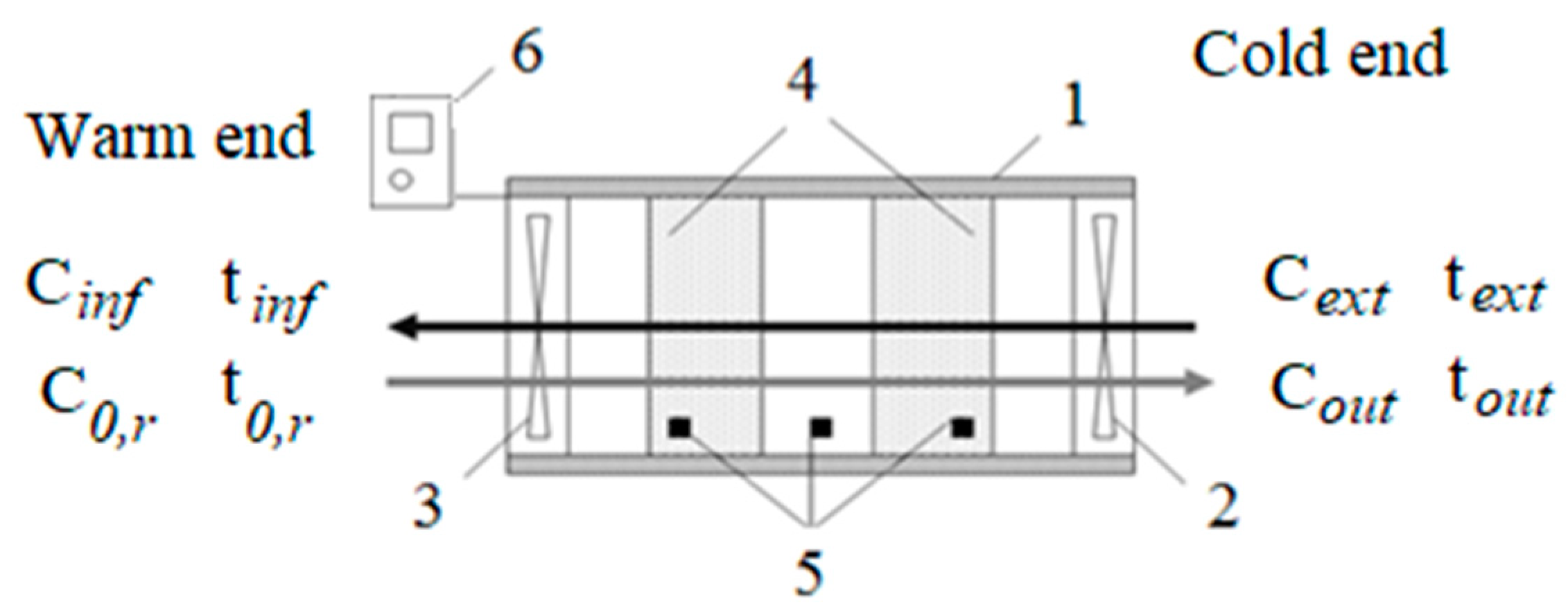
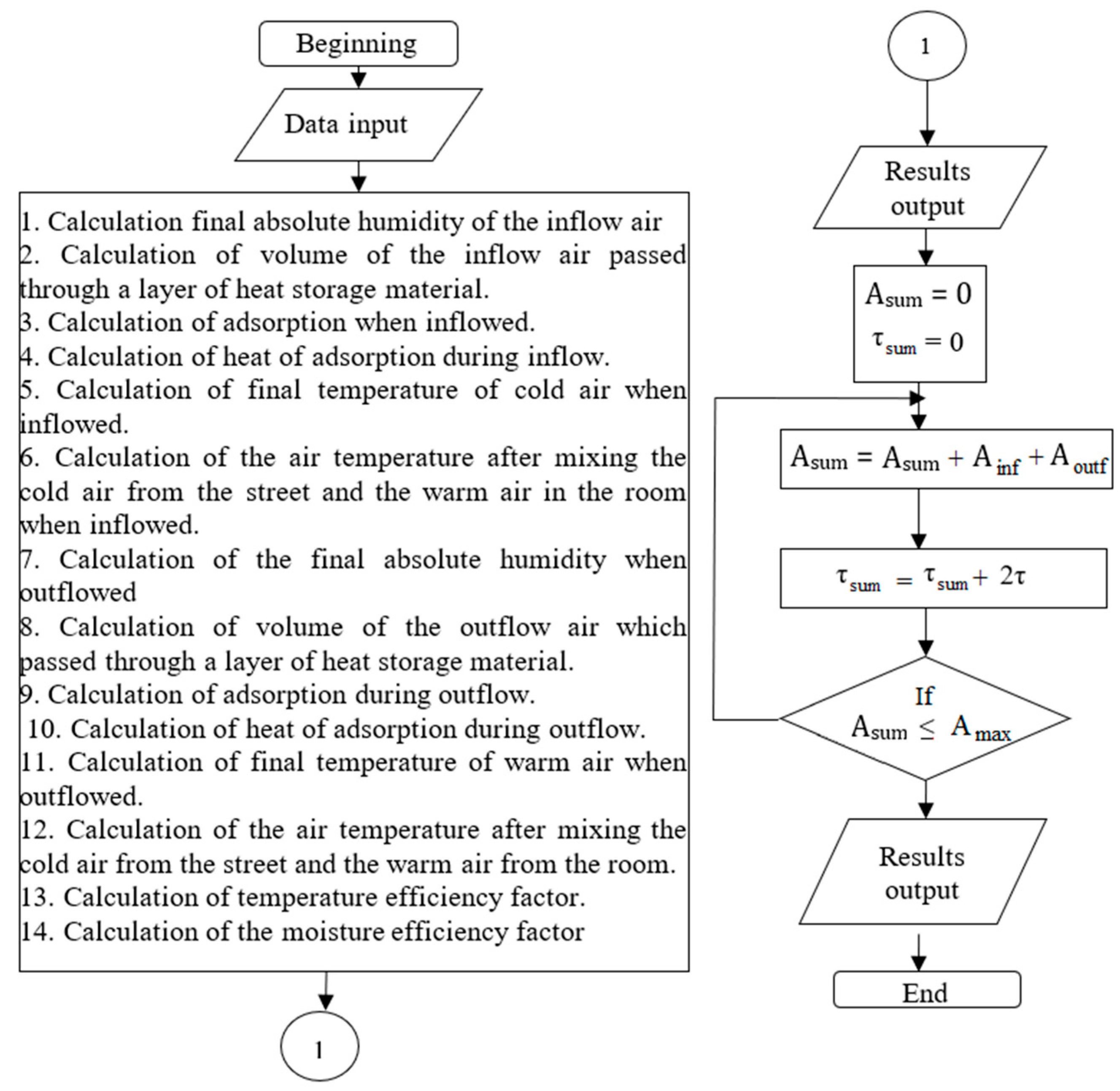
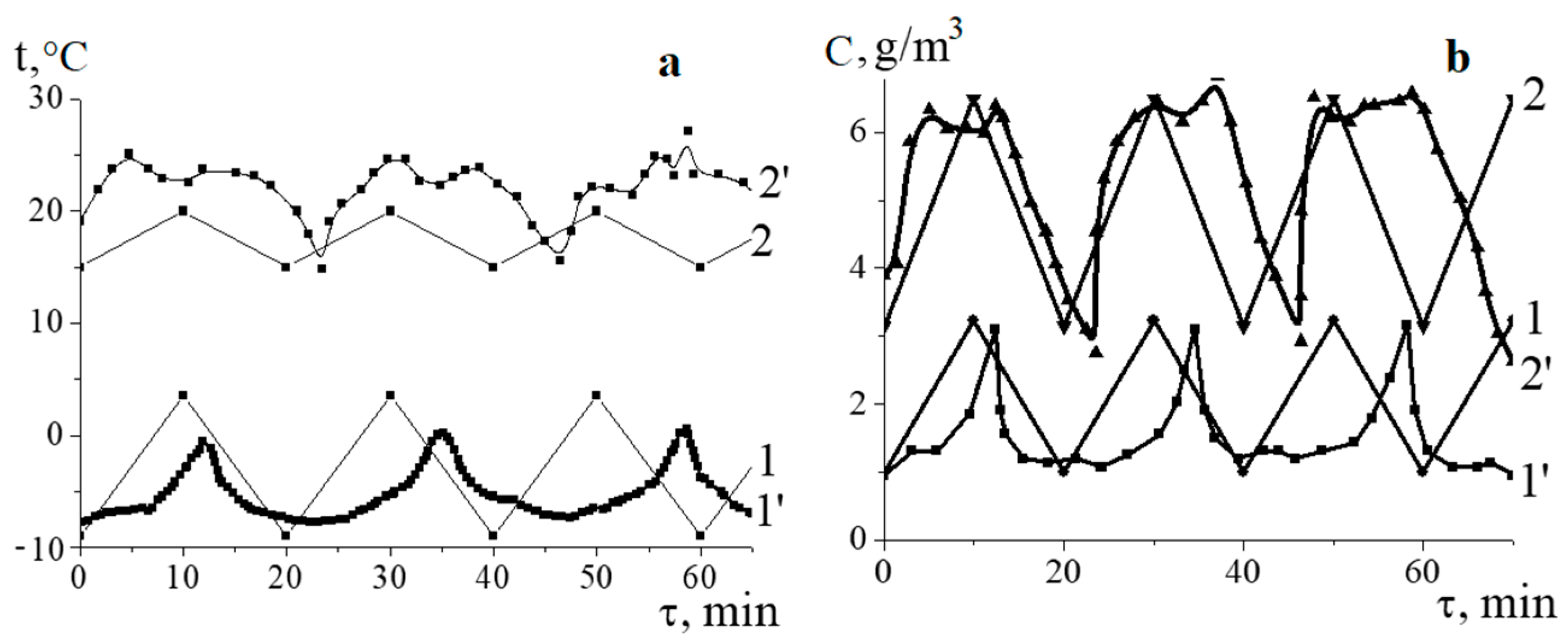
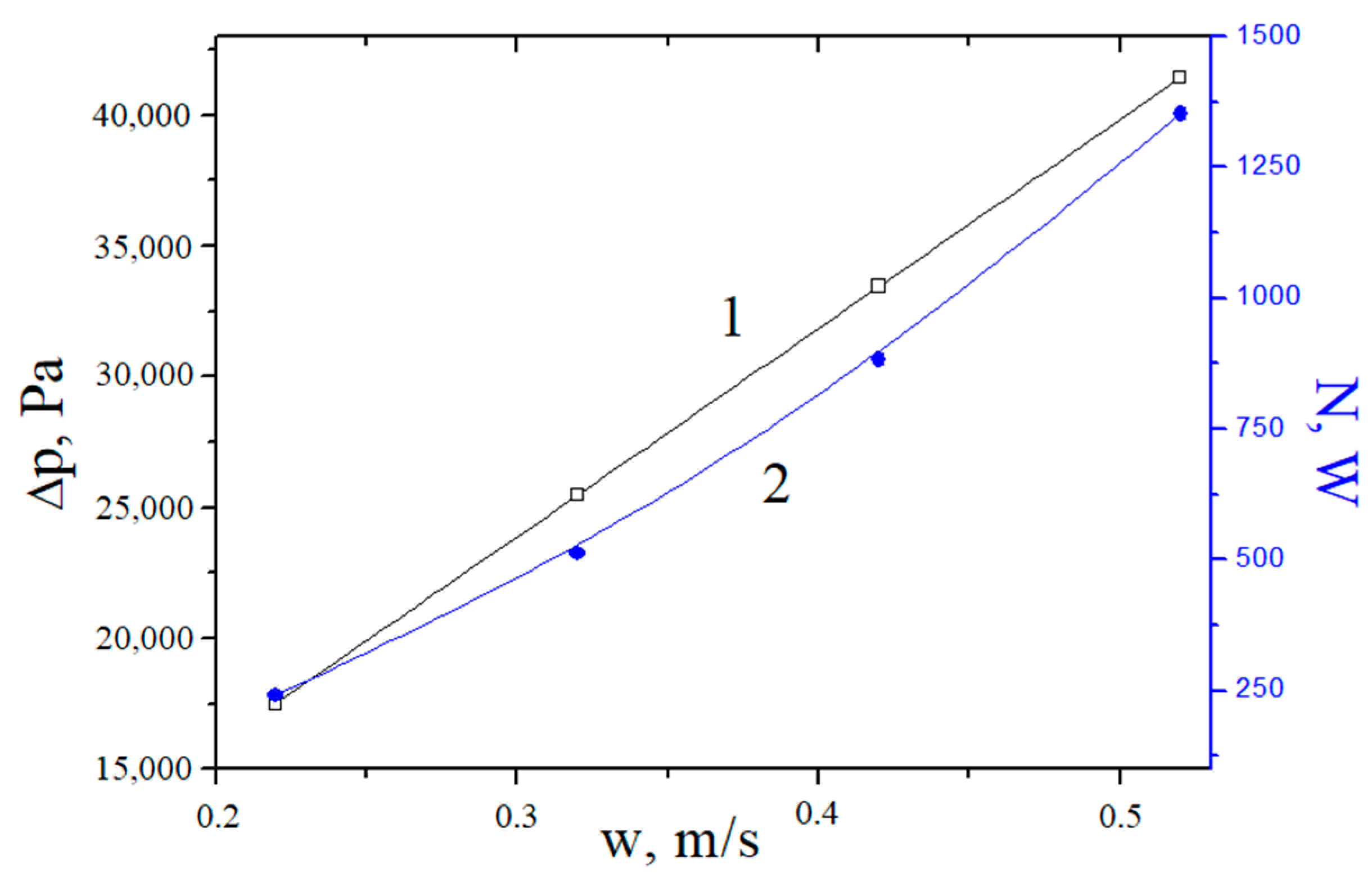
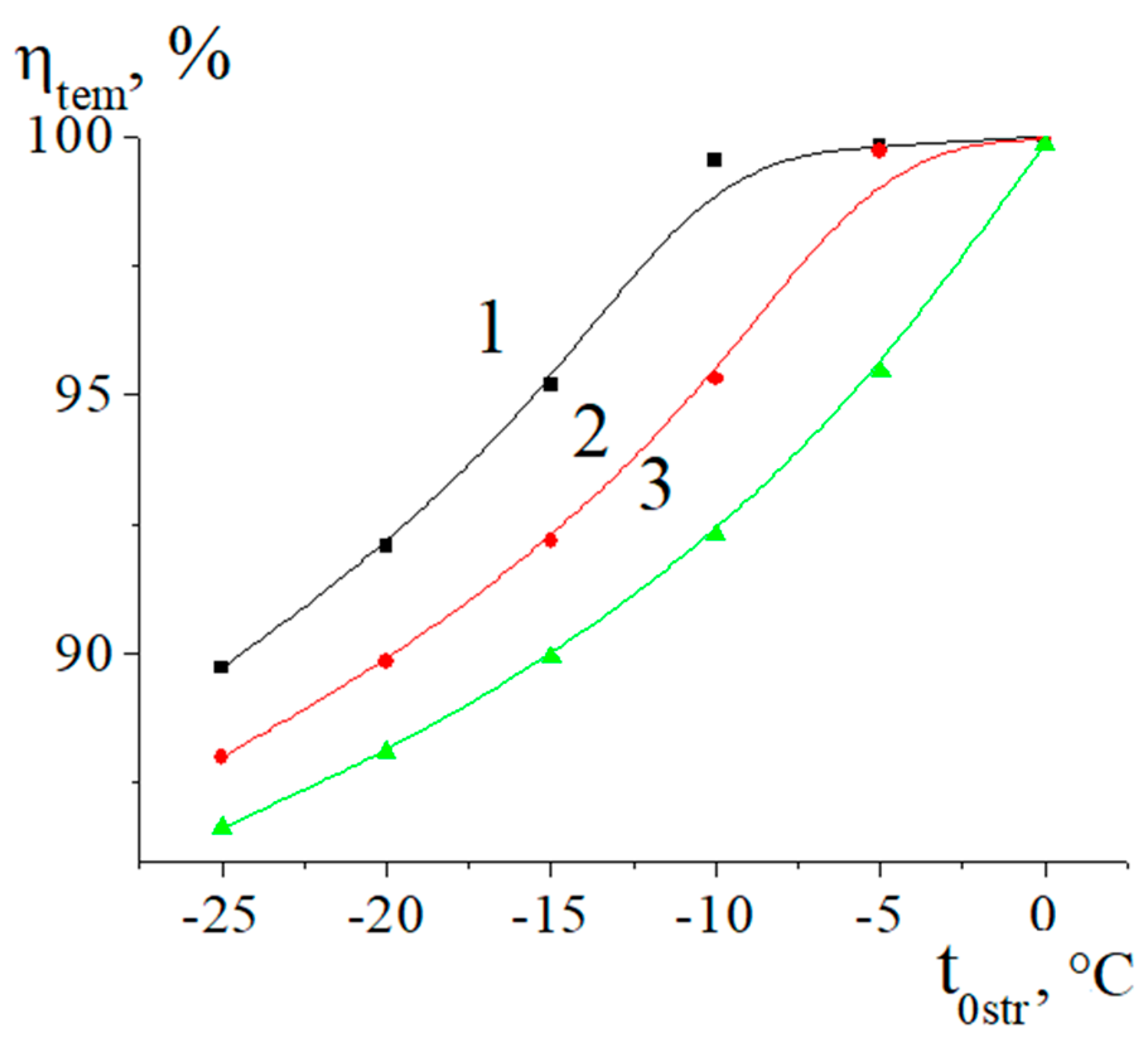


| Silica Gel, % | Na2SO4, % | Maximal Adsorption, Amax, kg/kg | Maximal Heat of Adsorption | Mads | Vads |
|---|---|---|---|---|---|
| kg | m3 | ||||
| 20 | 80 | 1.055 | 3506 | 96.5 | 0.134 |
| 40 | 60 | 0.842 | 2807 | 120.5 | 0.167 |
| 60 | 40 | 0.628 | 2093 | 161.6 | 0.22 |
| 80 | 20 | 0.414 | 1380 | 245.1 | 0.34 |
© 2020 by the authors. Licensee MDPI, Basel, Switzerland. This article is an open access article distributed under the terms and conditions of the Creative Commons Attribution (CC BY) license (http://creativecommons.org/licenses/by/4.0/).
Share and Cite
Belyanovskaya, E.; Rimár, M.; Lytovchenko, R.D.; Variny, M.; Sukhyy, K.M.; Yeromin, O.O.; Sykhyy, M.P.; Prokopenko, E.M.; Sukha, I.V.; Gubinskyi, M.V.; et al. Performance of an Adsorptive Heat-Moisture Regenerator Based on Silica Gel–Sodium Sulphate. Sustainability 2020, 12, 5611. https://doi.org/10.3390/su12145611
Belyanovskaya E, Rimár M, Lytovchenko RD, Variny M, Sukhyy KM, Yeromin OO, Sykhyy MP, Prokopenko EM, Sukha IV, Gubinskyi MV, et al. Performance of an Adsorptive Heat-Moisture Regenerator Based on Silica Gel–Sodium Sulphate. Sustainability. 2020; 12(14):5611. https://doi.org/10.3390/su12145611
Chicago/Turabian StyleBelyanovskaya, Elena, Miroslav Rimár, Roman D. Lytovchenko, Miroslav Variny, Kostyantyn M. Sukhyy, Oleksandr O. Yeromin, Mikhailo P. Sykhyy, Elena M. Prokopenko, Irina V. Sukha, Mikhailo V. Gubinskyi, and et al. 2020. "Performance of an Adsorptive Heat-Moisture Regenerator Based on Silica Gel–Sodium Sulphate" Sustainability 12, no. 14: 5611. https://doi.org/10.3390/su12145611
APA StyleBelyanovskaya, E., Rimár, M., Lytovchenko, R. D., Variny, M., Sukhyy, K. M., Yeromin, O. O., Sykhyy, M. P., Prokopenko, E. M., Sukha, I. V., Gubinskyi, M. V., & Kizek, J. (2020). Performance of an Adsorptive Heat-Moisture Regenerator Based on Silica Gel–Sodium Sulphate. Sustainability, 12(14), 5611. https://doi.org/10.3390/su12145611








